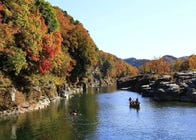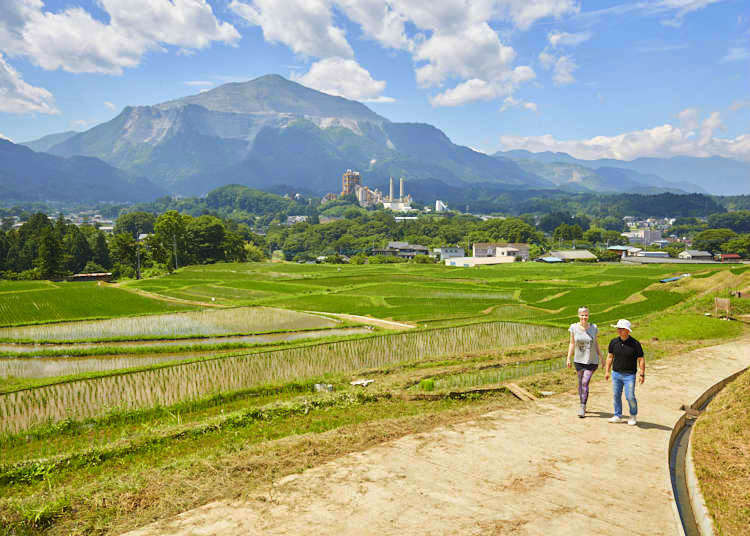
Our Tokyo day trip to Chichibu, Saitama was planned by Mr. Tetsu Morita, who was actively involved in the production of the Michelin Green Guide Japan. With his familiarity of Westerners’ tastes, he provides a view of Japan that even Japanese people themselves might not be aware of.
Chichibu, in Saitama Prefecture, is just northwest of Tokyo. The town is famous for the Chichibu Night Festival, a stunning event that has been registered as a UNESCO intangible cultural heritage. But what other things are there to discover in and around Chichibu? This time, Morita-san is joined by Pamela, a German-born editor at LIVE JAPAN.
Starting our adventure at Seibu Chichibu Station

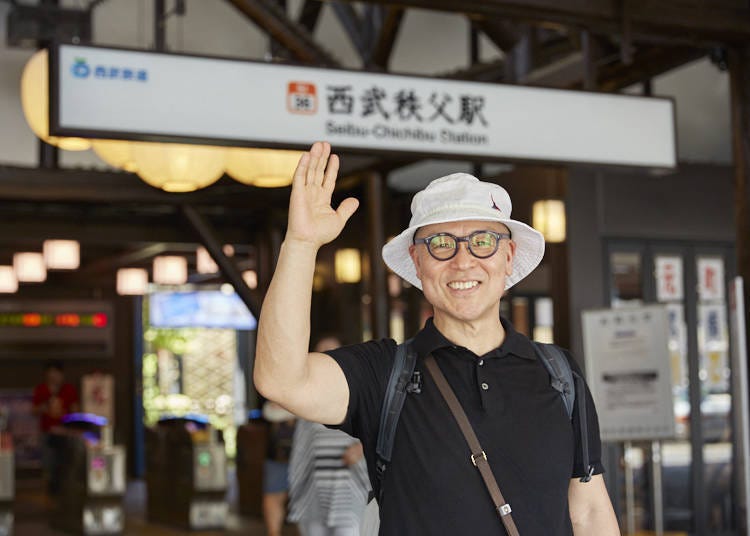
We meet at Seibu Chichibu Station and will move on to the neighboring Yokose Station from there.
Terasaka Rice Terrace: Gorgeous Fields with Mount Bukō Towering in the Distance
Morita-san took the Red Arrow express train to get to Yokose Station from Tokyo where he meets Pamela. From there, the first spot to visit on our Culture Walk is the Terasaka Rice Terrace.
The scenic fields are a 15-minute walk away from the station, suddenly appearing in front of us as lush green fields and glistening water. A path snakes its way through the terraced paddies, inviting visitors to walk right along the rice plants and a rustic pavilion provides both shade from the sun and a place to rest one’s legs while taking in the view.
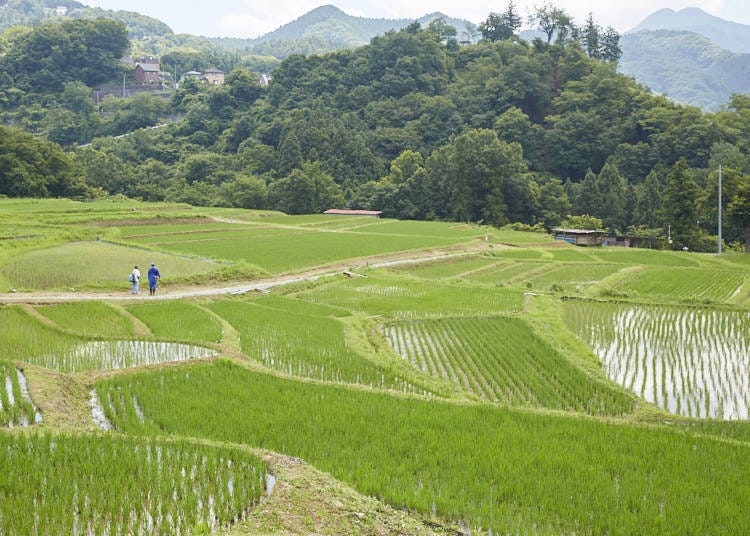
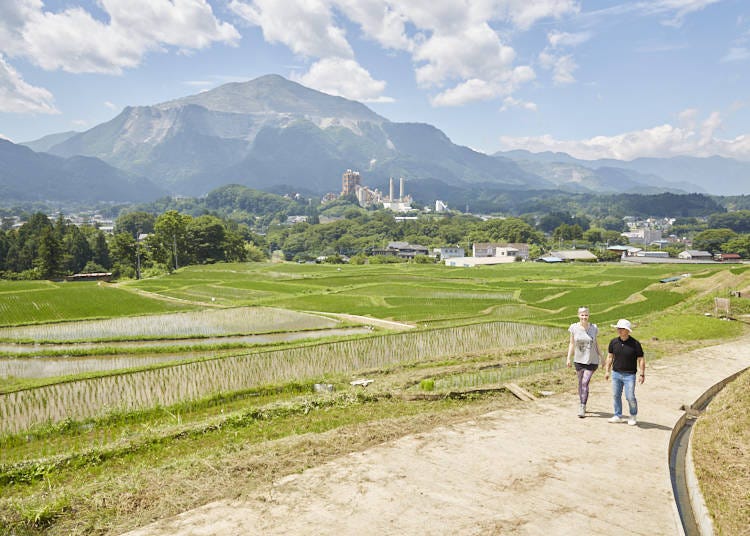
The Terasaka Rice Terrace is Saitama’s largest paddy field terrace. It spans on an area of about 4 hectares and boasts about 250 individual rice fields.
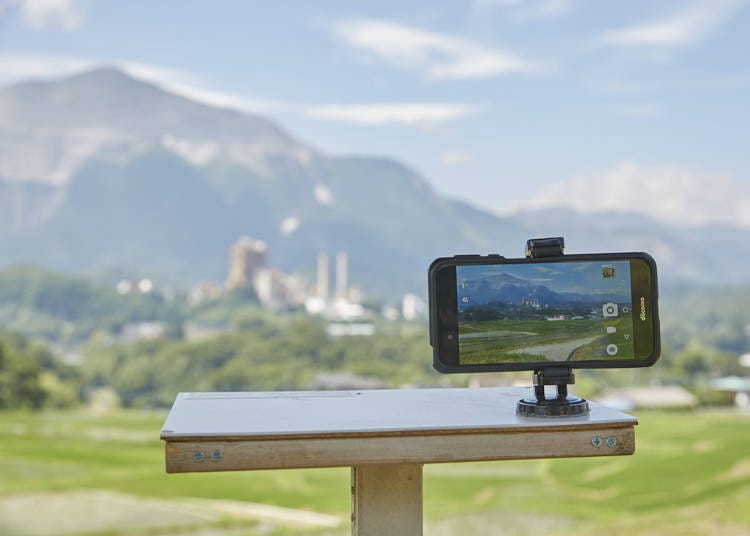
Pamela: “What beautiful scenery! This is what I imagine when I think of Japan.”
Morita: “It is said that rice has been cultivated on this very terrace since the Kamakura era in the 12th century. There must have been a lot of small paddy fields on the flops of the mountain. Even now, the locals take care of these terrace fields diligently.
People often think that these fields have been tended to continuously for centuries, but they actually were abandoned and lay waste after the Pacific War. In 2001, however, local farmers started to revive the rice terrace as a ‘heritage of the area’ with the goal to preserve and protect it in the long term. At the moment, only these rice paddies have been restored. Flood control is crucial when it comes to operating such a field, so the local community cooperates to protect and preserve these flood control technologies, that’s why only this rice grows as of right now.
Large farming machinery cannot be used and these fields are rather inefficient compared to large paddy fields, so keeping them and protecting them is not a simple task. However, the people do it because they deem the Terasaka Rice Terrace important and worthy of protection, even if that has to be done by manual labor.”
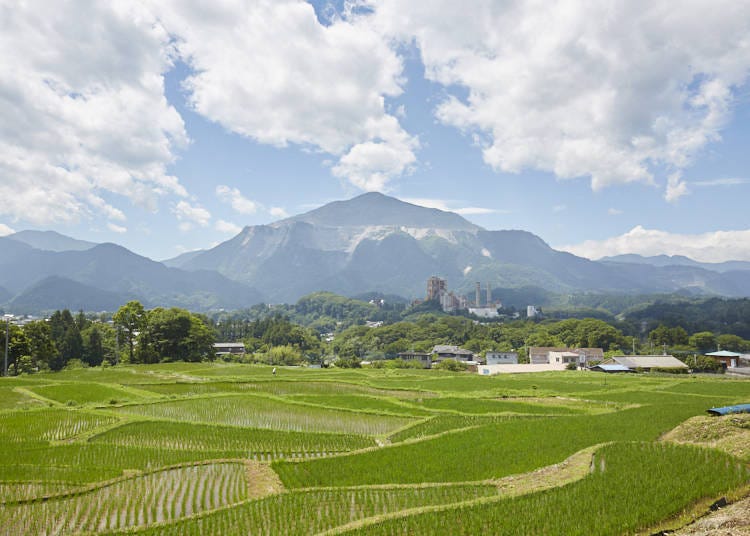
Pamela: “What about that mountain in front of us? Part of the top seems to have vanished...”
Morita: “That is Mount Bukō and you could also call it the symbol of Chichibu. It’s said to be the kami’s mountain where a dragon deity lives. Next to being a place of faith, Mount Bukō is also known for its high-quality limestone. Limestone mining started around 1940, causing its current shape. The factory you see at the foot, that is where cement is made from the mined limestone.”
Pamela: “So a mountain believed to be the dwelling of a kami is mined for limestone to make cement?”
Morita: “The limestone mining is one of Chichibu’s most important industries. And although the locals are aware that it changes the shape of the kami’s mountain, they also see the limestone as a blessing from that kami and believe that the kami is quite literally letting its body being carved for the development of Chichibu. In order to live, humans receive great blessings from nature.
But that also means that we more or less destroy nature. We cut down trees for wood and mine mountains for stone to use them to build paths over the mountain and erect dams at its foot. Generally, it is hard to understand that kind of sacrifice we make for these benefits while living in the city. However, looking at this scenery really makes you understand how amenities and our convenient way of life is based on nature’s gifts.
Both Mount Bukō and the Terasaka Rice Terrace are such important gifts of nature. It is something we have to protect, by manual labor if need be, but it is also something that bestows its blessings upon us. Development and conservation...these concepts seem contradictory in some way, but I think you could say that Japan’s positive spirit or will is able to accept this state without a deep conflict regarding this contradiction.
Although the preservation and operation of these rice paddies requires hard labor, seeing the intense scenery of Mount Bukō towering over the rice terrace really makes you ponder about what we take from nature to lead our modern lives.”
Pamela: “It does indeed. The limestone from this mountain becomes concrete, which is then used to construct modern buildings in Tokyo. It’s an inspiring spot for sure. I’d love to spend a quiet afternoon here, leisurely reading a book or getting lost in thought.”
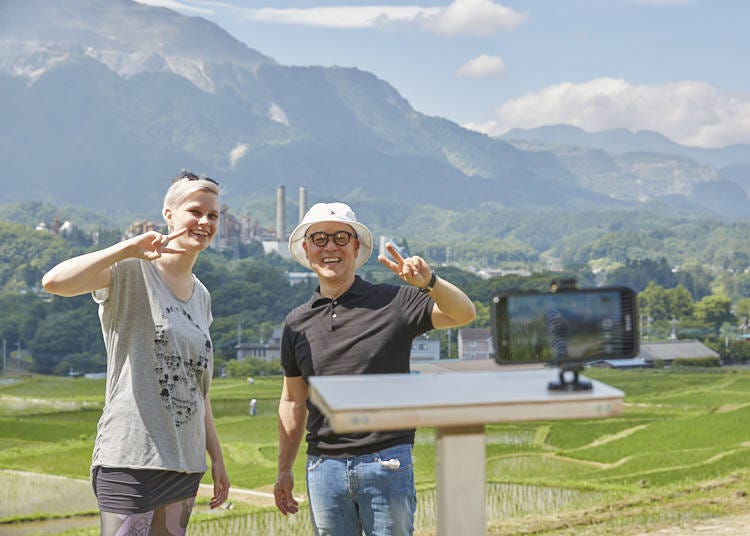
-
Terasaka Rice Terrace寺坂棚田
- Address 1896 Yokoze, Yokoze-machi, Chichibu-gun, Saitama 3680072, Japan / 〒368-0072 埼玉県秩父郡横瀬町大字横瀬1846
-
Nearest Station
Yokoze Station (Seibu Chichibu Line), 15 minutes on foot
- Phone Number 0494-25-0114
Bukozan Museum: Discovering Mount Bukō and its Gifts to Modern, Urban Life
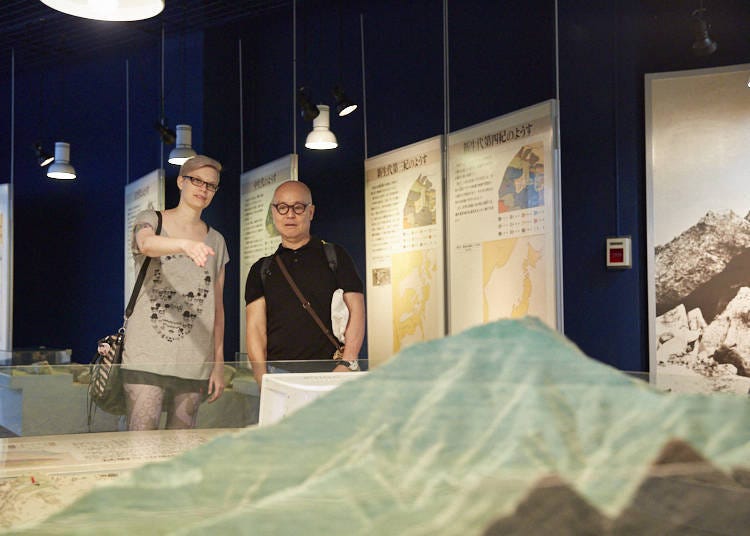
After taking in the scenery from the paddy fields, Morita-san and Pamela make their way to Bukozan Museum on the east side of Hitsujiyama Park, a short walk away from Seibu Chichibu Station. The museum was created to showcase and educate about Mount Bukō, its limestone, and what purposes it serves in our daily lives. There are realistic dioramas, the history of the mountain, its geographical features, flora and fauna, and all sorts of other interesting data and information to be discovered.
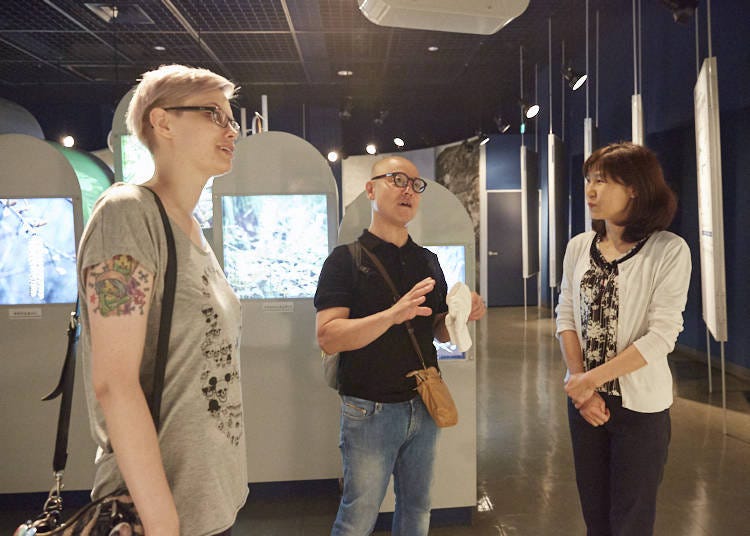
Morita: “Chichibu is close to Tokyo and both the Arakawa River and Seibu Railway can be used for transport, the limestone mined at the mountain comes to Tokyo as concrete. Not only the locals profit from the blessings of Mount Bukō but so do the people living in urban areas. It’s just like you said earlier, Pamela, knowing this makes you look at Tokyo’s modern buildings from a different perspective.”
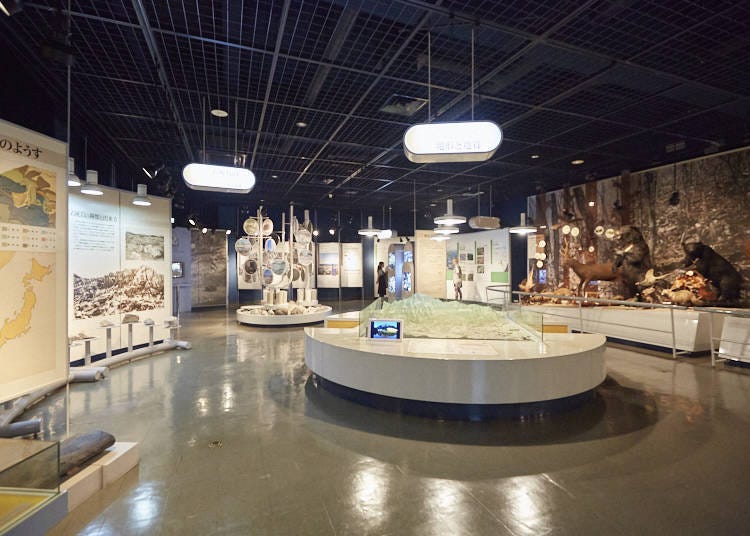
-
Bukozan Museum武甲山資料館
- Address 6176 Ōmiya, Chichibu-shi, Saitama 3680023, Japan / 〒368-0023 埼玉県秩父市大宮6176
-
Nearest Station
Seibu Chichibu (Seibu Chichibu Line), 15 minutes on foot
- Phone Number 0494-24-7555
Hours: 9:00 a.m. – 4:00 p.m.
Closed: Tuesdays (open on national holidays), 12/29 – 1/3
Chichibu Shrine: Stunning Traditional Wood Carvings by the Legendary Hidari Jingorō
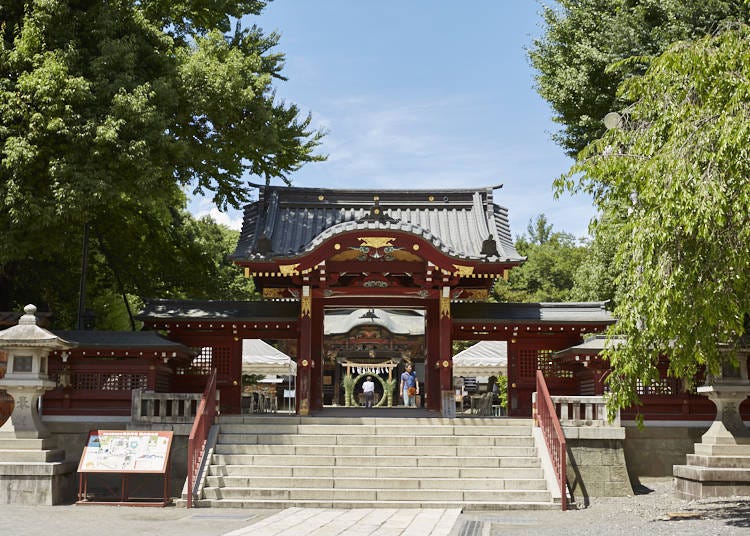
The next stop on our culture walk is Chichibu Shrine where the Shintō deity of the area is enshrined. The most prestigious event of this shrine is the Chichibu Night Festival.
The name of the deity that is worshipped here is Ame-no-minakanushi ("Heavenly Ancestral God of the Originating Heart of the Universe"), who has once been associated with the Buddhist deity called Myōken Bosatsu. Even today, a lot of locals refer to the deity and believe in it as Myōken-sama.
On December 3, the day of the Chichibu Night Festival, the male dragon kami of Mount Bukō and Myōken-sama, who is the female deity of Chichibu Shrine, meet each other once a year. That meeting is celebrated in grand fashion with the shrine’s festival.
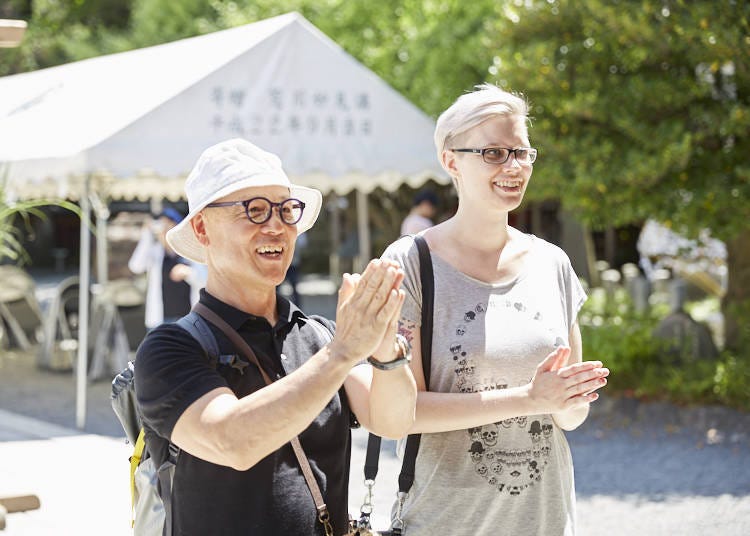
Pamela: “The colors of Chichibu Shrine look similar to Nikkō Tōshō-gū Shrine, don’t they. Is there a connection between the two of them?”
Morita: “Yes, actually. The current Chichibu Shrine is a reconstruction of the building donated by Tokugawa Ieyasu in 1592. Nikkō Tōshō-gū Shrine was built to worship Tokugawa Ieyasu, so there is a rather deep connection.”
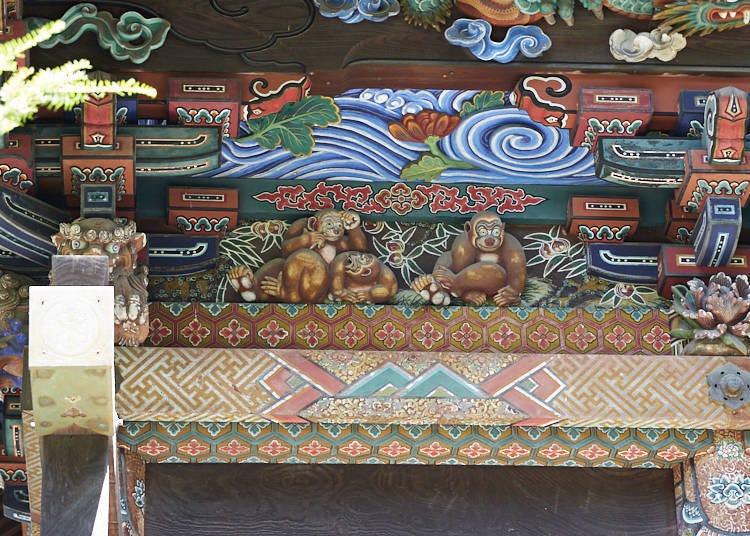
Pamela: “There are even the Three Wise Monkeys, just like at Nikkō Tōshō-gū Shrine.”
Morita: “At Nikkō Tōshō-gū, the young monkeys have the poses of ‘hear no evil,’ ‘see no evil,’ and ‘speak no evil.’ They’re children, that’s why the message is supposed to be not being influenced by bad things. But the Three Wise Monkeys at Chichibu Shrine are adults. Their poses mean ‘look well,’ ‘listen well,’ and ‘speak well,’ an encouragement to live a good life.”
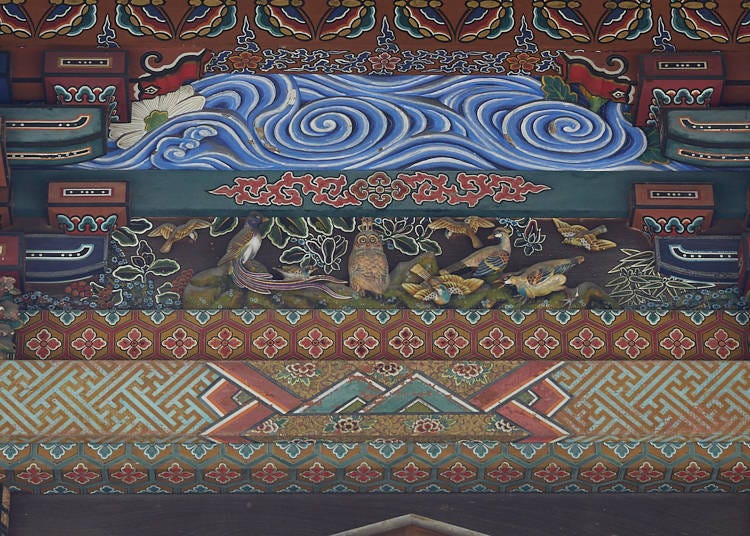
Morita: “The owl carving on the back side of the shrine’s main building is called ‘the Owl of the North Star.’ Its body faces south but its head is turned towards north, protecting Ame-no-minakanushi, the deity of this shrine who is also seen as the spirit of the North Star. In Japan, the owl has been a symbol of wisdom since ancient times. On top of that, it’s Japanese name fukurō can also be understood as ‘anti-misfortune,’ so the owl is also a lucky charm. In Europe, the owl symbolizes wisdom as well, doesn’t it?”
Chichibu Shrine, lovingly called Myōken-san by the locals, enshrines the deity of the Chichibu area. Even nowadays, the shrine seems to never be quite empty, with people always standing in front of the main shrine, closing their eyes in prayer. It’s a symbol of the long-lasting faith that has been so dear to the people of the area, to a point where one of the shrine’s largest festivals has become famous far beyond Chichibu itself.
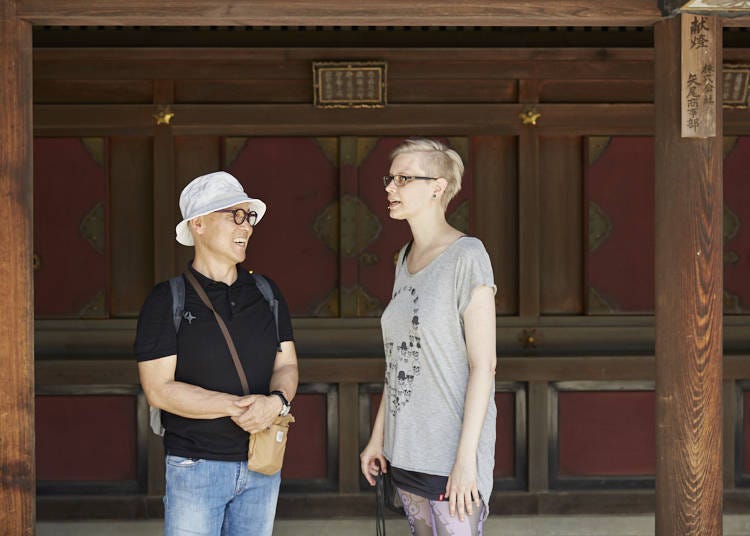
-

-
Address
Chichibu-shi, Saitama Banba 1-3, 368-0041
View Map -
Nearest Station
Chichibu Station (Chichibu Railway)
3 minutes on foot
- Phone Number 0494-22-0262
-
Address
Chichibu-shi, Saitama Banba 1-3, 368-0041
Chichibu Matsuri Kaikan: a Virtual Experience of the Chichibu Night Festival, a UNESCO Intangible Cultural Heritage
The Chichibu Matsuri Kaikan (“Festival Hall”) is right next to Chichibu Shrine and showcases the Chichibu Night Festival, which is one of the 33 festivals that have been registered as a UNESCO Intangible Cultural Heritage under the name “Yama, Hoko, Yatai, float festivals in Japan.” It dates back about 300 years and is the biggest festival of Chichibu Shrine, featuring large floats and lanterns arranged like an umbrella called kasahoko – the Matsuri Kaikan lets you experience this famous festival in a fun and authentic manner.
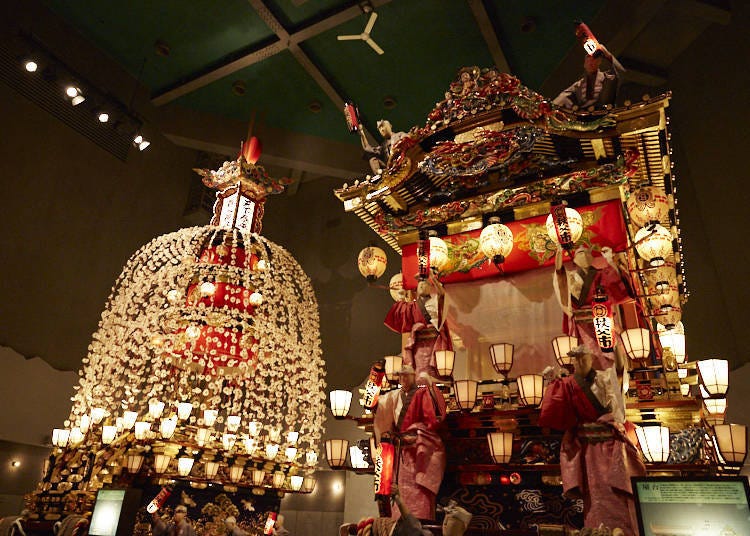
Pamela: “Are these the actual floats of the Chichibu Night Festival?”
Morita: “Well, these kasahoko and floats were made for this exhibition. Apparently, the production cost of these floats that were made 34 years ago is two billion yen. The two kasahoko and four floats that are actually part of the night festival are registered as national important tangible folk-cultural properties. Each of them is stored and managed by the town council of each area.”
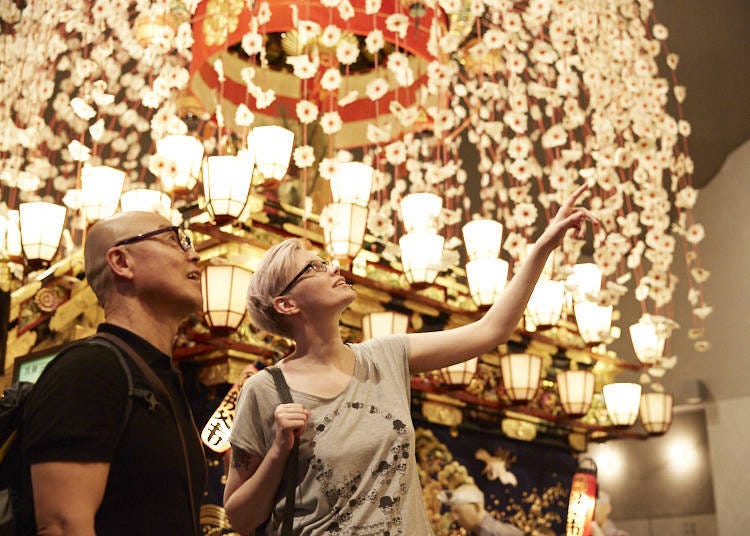
The festival hall boasts its own 3D video and projection mapping of the Chichibu Night Festival. It even features a little scene of the dragon kami of Mount Bukō leaving the mountain to meet Ame-no-minakanushi. The atmosphere of the city during the festival is realistically portrayed, to the point where the replica of the float and the kasahoko seem to be moving right in front of your eyes with the help of both video and sound.
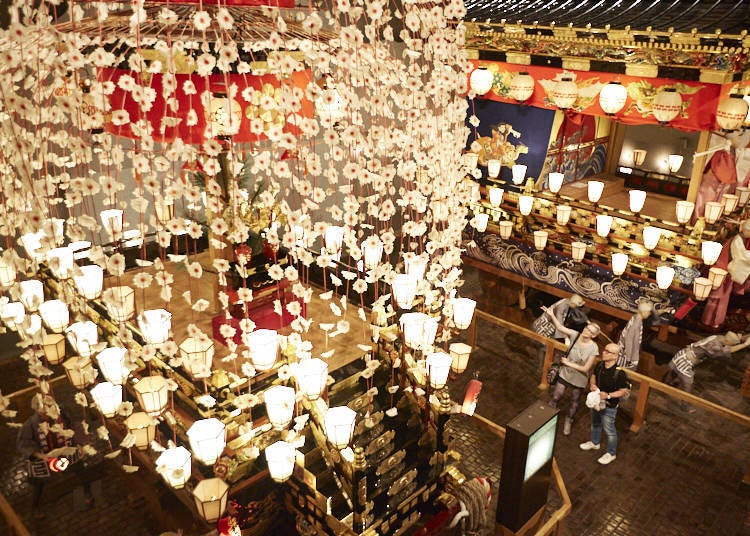
-
Chichibu Matsuri Kaikan秩父まつり会館
- Address 2-8 Banbamachi, Chichibu-shi, Saitama 3680041, Japan / 〒368-0041 埼玉県秩父市番場町2-8
-
Nearest Station
Seibu Chichibu Station (Seibu Railway), 15 minutes on foot / Chichibu Station (Seibu Chichibu Line), 3 minutes on foot
- Phone Number 0494-23-1110
Hours: 9:00 a.m. - 5:00 p.m. (April to November)
10:00 a.m. - 5:00 p.m. (December to March)
Last admission: 4:30 p.m.
Closed: every 4th and 5th Tuesday of the month, December 29 to January 1
Chichibu Museum: A Treasure Trove of Ancient Buddhist Statues and Artworks, Local Painters, and Antiquities
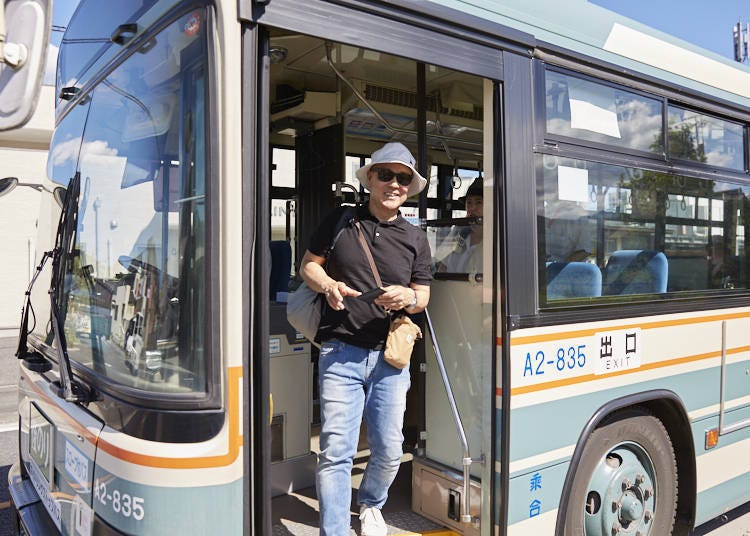
After getting a taste of Chichibu’s famous Night Festival, we continue our Culture Walk by Seibu Kanko Bus to visit the Chichibu Museum.
It’s a private art museum that exhibits both precious Buddhist artworks as well as paintings from artists of the area. It began with the personal collection of director Tomio Nishi, initially planned to be a market for antique art as he himself was engaged in antiquity trade. This background is still very much alive at the resting space next to the museum, where all sorts of antiquities are sold. Swords, samurai armor, Buddhist statues, antique tableware, ukiyoe prints, calligraphy hanging scrolls...the selection is vast and seems endless!
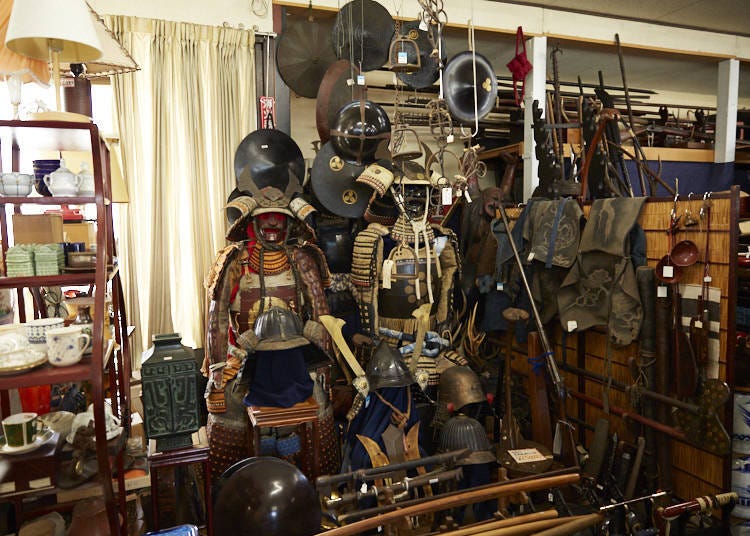
After enjoying the many antiquities, we moved on to the Chichibu Museum. The second floor is all about Buddhism and hides a surprising number of ancient items and unusual treasures from all around the world.
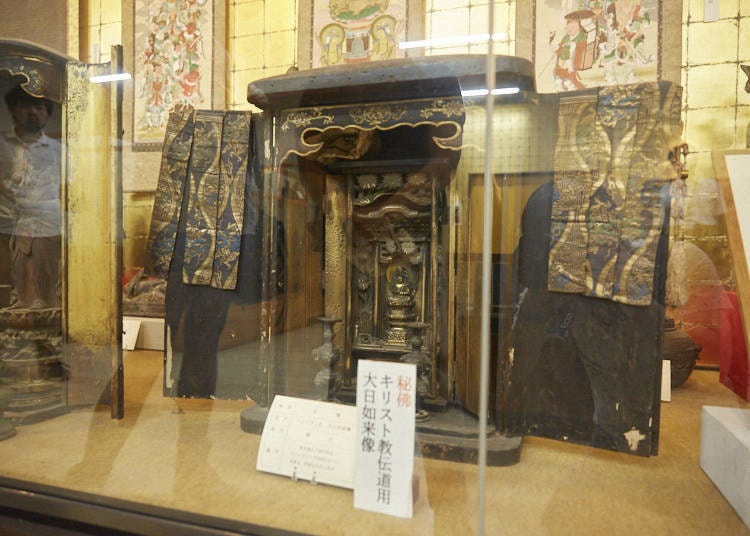
A Dainichi Nyorai Buddha statue used for Christian missionary work from the Nanboku-chō period.

A tablet called fumi-e used to discover Christians in hiding. People had to trample on the image to demonstrate their lack of Christian faith.
Pamela: “There aren’t only Buddhist statues from Japan, but also scriptures from China and a Tibetan vajra! These are real international treasures.”
Morita: “I’m surprised to see a real fumi-e on display. If you look at the Dainichi Nyorai Buddha statue here from the Nanboku-chō period, it becomes rather clear that Japan has a history of adapting religions from other countries and fusing them with its own beliefs.”
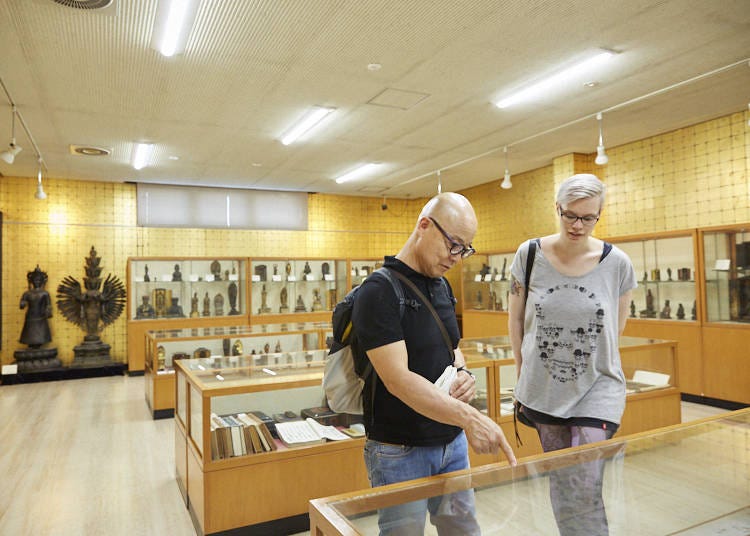
The spacious exhibition room in the museum’s annex shows large paintings of local artists from Chichibu, showing their hometown in various different ways.
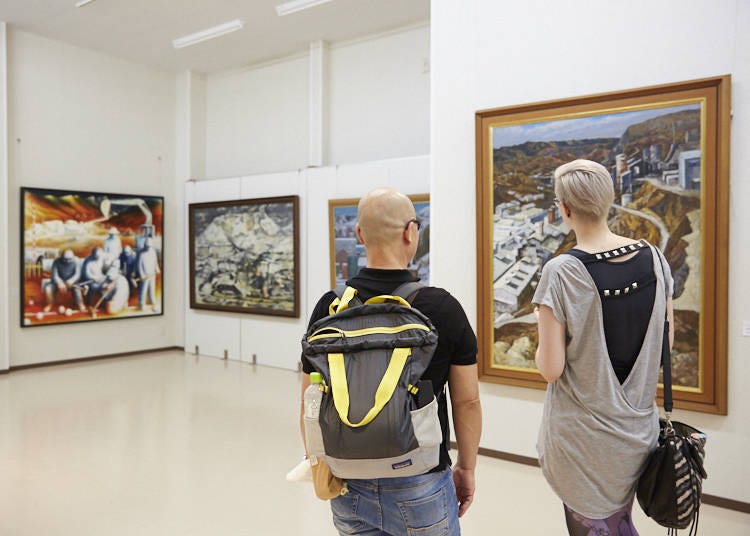
Morita: “Mount Bukō, Chichibu’s symbol, is prominently featured in many paintings, right? Drawn by the local artists, the mountain really seems intense. I feel like a lot of them express the dilemma of mining the mountain of a kami for their own livelihood.”
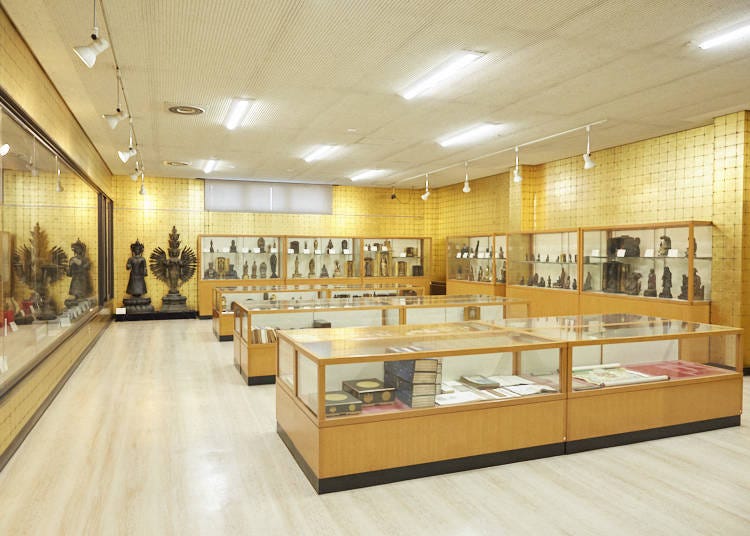
-
Chichibu Museum秩父美術館
- Address 7-1 Nagatamachi, Chichibu-shi, Saitama 3680013, Japan / 〒368-0013 埼玉県秩父市永田町7-22
-
Nearest Station
Seibu Chichibu Station (Seibu Chichibu Line), via Seibu Kanko Bus. Get off at “Aioichō,” then walk for another 5 minutes.
- Phone Number 0494-23-1177
Hours: 10:00 a.m. - 5:00 p.m. (last admission at 4:00 p.m.)
Closed: Tuesdays, December 25 to January 4
Mahollo BAR: Savoring Local Beers from Chichibu on the Road to Chichibu Shrine

The final stop on our Chichibu Culture Walk is Mahollo Bar. The bar serves local beers from the Chichibu area, staying on topic with your trip to discover local tradition and daily life. It’s right in the middle of the road that’s the shrine approach to Chichibu Shrine.
At Mahollo Bar, look forward to savoring “Chichibu Beer” crafts beers from a local brewery called “Bear Meet Beer.” On tap is the Mahollo Weizen (1,100 per pint, tax included) perfect for hot summer days, the India Session Lager (1,100 per pint, tax included), a red ale called Benikuma X (1,100 per pint, tax included), and many more. There are a lot of choices available and every beer lover is sure to find something that suits their taste.
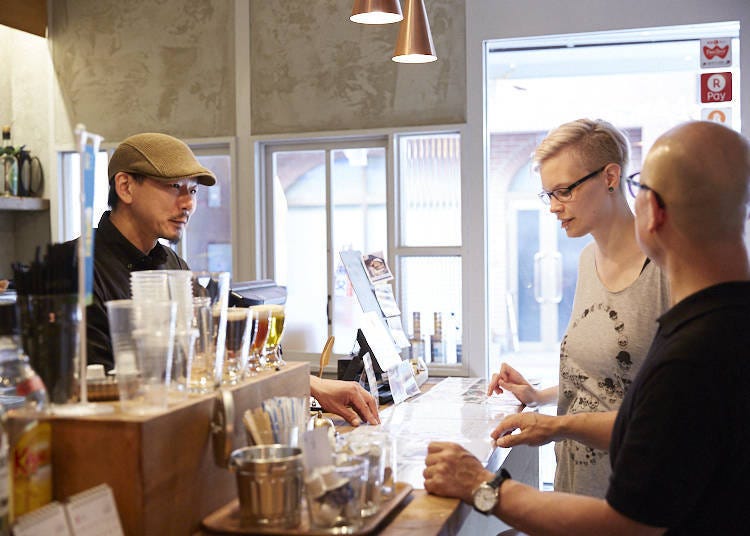
Morita: “Savoring local craft beer at the end of our Chichibu trip is the best, isn’t it? I’ll go with the red ale.”
Pamela: “It really is. Since it was such a hot day today, I’ll cool down with a refreshing white beer.”
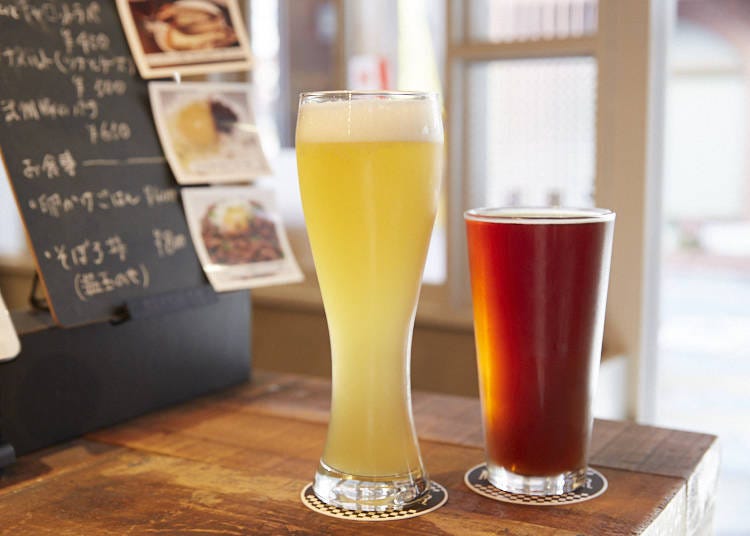
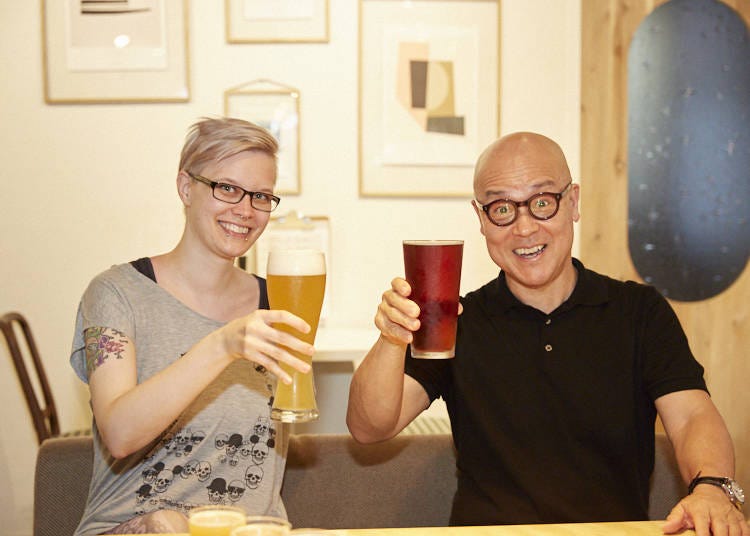
Morita: “From the paddy fields that have existed since the Kamakura Period to Mount Bukō and Chichibu Shrine, the iconic symbols of the area, we visited many spots representative of and essential for Chichibu. What do you think, how did you like it?”
Pamela: “Well, I really came to realize that the people of Chichibu lead their lives with Mount Bukō towering over them, cherishing tradition and protecting local culture as a community. The Chichibu Night Festival has been passed down in that way for more than 300 years, right?”
Morita: “That is true. You could say that the people coexist with the kami and nature while receiving the gifts from the dragon deity living on Mount Bukō. The mountain and the Chichibu Night Festival are a symbol of the local community supporting, protecting, and nurturing the tradition, culture, and nature of the Chichibu area, even nowadays.”
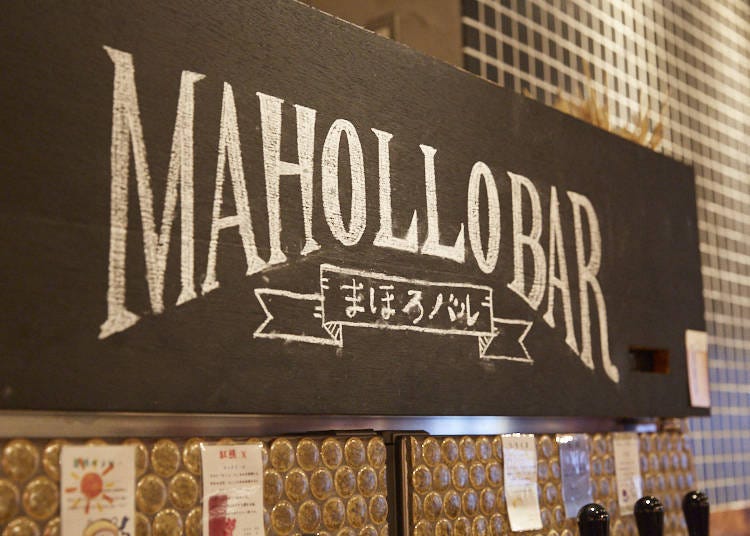
-
Mahollo BAR.まほろバル
- Address 17-14 Banbamachi, Chichibu-shi, Saitama 3680013, Japan / 〒368-0041 埼玉県秩父市番場町17-14
-
Nearest Station
Seibu Chichibu Station (Seibu Chichibu Line), 8 minutes on foot
- Phone Number 0494-26-7303
Hours: 11:00 a.m. – 8:00 p.m.
Closed: Wednesdays, Thursdays
Our Chichibu Culture Walk started with the stunning yet contrasting landscape of ancient rice paddies carefully tended to by the locals and Mount Bukō in the background, its shape changed forever by limestone mining. And yet, it is precisely that what makes the people of Chichibu feel close to the dragon deity that is believed to live on the mountain.
Proof of that is the Chichibu Night Festival that celebrates the annual meeting of the dragon deity and Ame-no-minakanushi, carried out for more than 300 years to this very day. In a way, our Culture Walk has become an intriguing glimpse into the complex, deep relationship between the people of Japan, their kami, and nature. It’s a fascinating harmony that is hard to explain and best experienced first-hand – we’ll be seeing you in Chichibu!
About Tetsu Morita
Tetsu Morita has worked several years for the French tire company Michelin before combing every nook and cranny of Japan to create the Michelin Green Guide Japan. He knows the country like the back of his hand – and all of its many secret spots that are incredibly fascinating, yet often overlooked by sightseers. Come with us in the “Tokyo Day Trips with Morita-san,” a series that explores little-known sightseeing spots all around Japan!
- Area
- Category
*Prices and options mentioned are subject to change.
*Unless stated otherwise, all prices include tax.
Popular Tours & Activitiess
Recommended places for you
-

Senso-ji Temple
Temples
Asakusa
-

Ueno Zoo (Ueno Zoological Gardens)
Zoos, Aquariums & Botanical Gardens
Ueno
-

Tsukiji Outer Market
Old Towns (Shitamachi)
Tsukiji
-

TOKYO SKYTREE®
Landmarks
Ryogoku / TOKYO SKYTREE(R)
-

Tokyo Metropolitan Government
Landmarks
Shinjuku
-

Kappabashi Street
Old Towns (Shitamachi)
Asakusa
-

Strawberries, Style, and Tokyo’s Coolest Neighborhood: Winter Afternoon Tea in Kichijoji
by: Guest Contributor
-

Jujutsu Kaisen Takes Over JR East With a Wrapped Shinkansen This Winter
by: Guest Contributor
-

New in Ginza! Air BicCamera Ginza Opens with a Faster, More Convenient Shopping Experience
by: Guest Contributor
-

First Japan Cherry Blossom 2026 Forecast Announced! Here's When & Where to See Sakura in Japan
-

Japan’s Shinkansen Is About to Change Travel in an Unexpected Way
by: Guest Contributor
-
Ad

(Opening in Jan 2026) 'THE SUMO LIVE RESTAURANT HIRAKUZA GINZA TOKYO!' 5 Exciting Ways to Experience the World of Sumo!
Inspiration for Accommodations
-

Enjoy Mt. Fuji from the Comfort of Your Room! Recommended Ryokan with Mt. Fuji View
-

Stay Near the Cherry Blossoms! Hotels for Cherry Blossom Viewing in Tokyo
-

Family-Friendly Hotels with Free Shuttle to Disneyland: Convenient Access for a Magical Stay
-

Top Ranked Hakone Hotels with Mt. Fuji View: Enjoy Stunning Scenery from Your Private Space
-

Convenient Tokyo Hotels with Airport Shuttle: Ideal for Families and Heavy Luggage
-

Stunning Tokyo Tower View Hotels: Enjoy Spectacular Scenery from Your Private Space
-

Convenient Asakusa Hotels with Kitchens: Ideal for Extended Family Visits
-

Experience Luxury: Hakone's 10 Best Five-Star Accommodations
-

Enjoy Mt. Fuji Autumn Leaves! Top Hotels Near the Popular Autumn Leaves Corridor
-

Experience Hakone Fall Foliage from Your Room with Stunning Views
-

Day Hiking Near Tokyo: 6 Easy Hikes You Can Do While Visiting Japan
-

Ueno Station Area Guide: Fun Ways to Explore Tokyo's Popular Destination (Area Map & Sightseeing Tips)
-

Tokyo Station Top 10 Sweets Ranking!
-

Explore, Eat, Relax - Welcome to the World of Onsen Gastronomy! Travel Japan's countryside, expand your culinary horizons, and soak in sumptuous hot springs
-

Ikebukuro Station Area Guide: Top 15 Spots When You Escape the Station's Maze!
-

Meiji Shrine (Meiji Jingu): Exploring the Sacred Sanctuary of Peace in Bustling Tokyo
- #best ramen tokyo
- #what to buy in ameyoko
- #what to bring to japan
- #new years in tokyo
- #best izakaya shinjuku
- #things to do tokyo
- #japanese nail trends
- #what to do in odaiba
- #onsen tattoo friendly tokyo
- #daiso
- #best sushi ginza
- #japanese convenience store snacks
- #best yakiniku shibuya
- #japanese fashion culture
- #best japanese soft drinks















